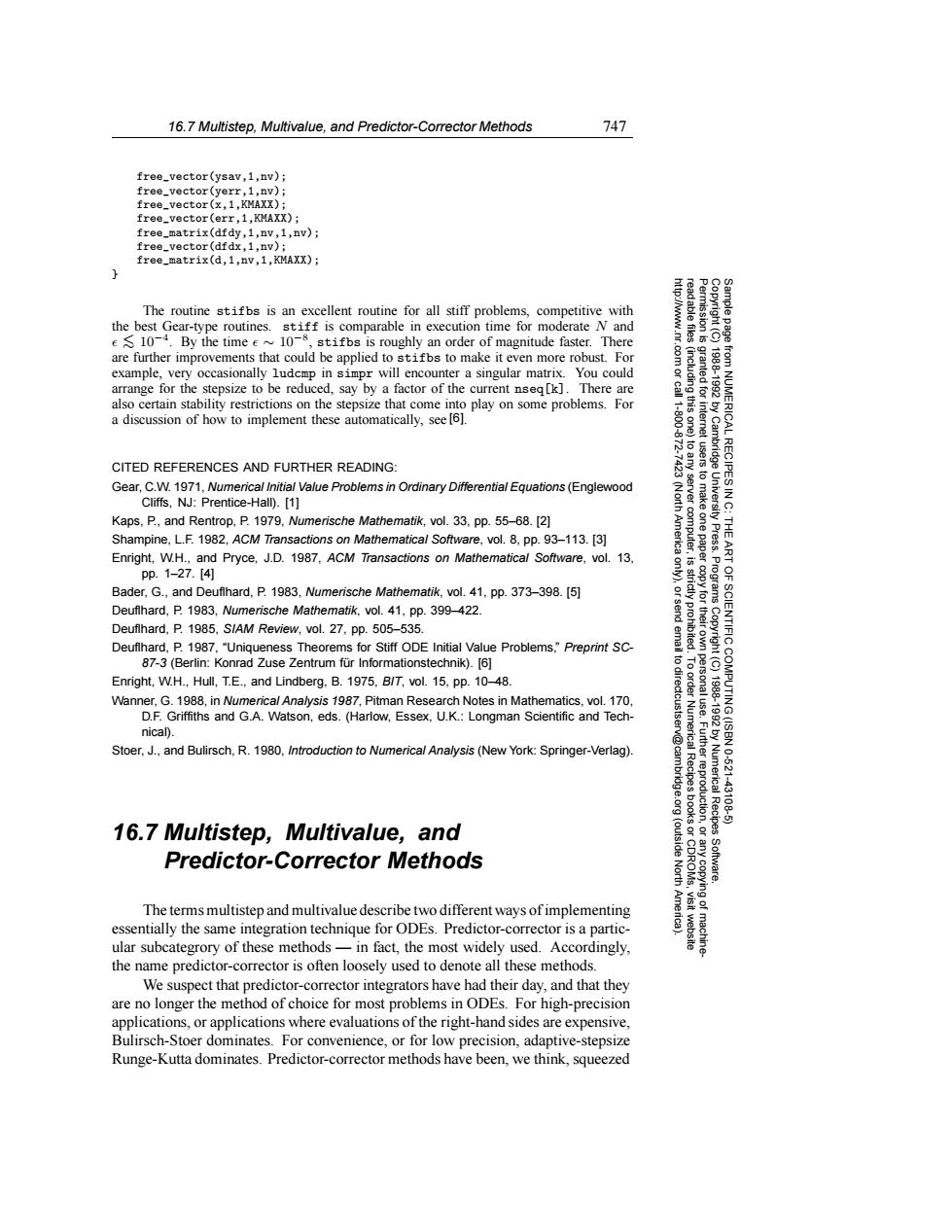正在加载图片...

16.7 Multistep,Multivalue,and Predictor-Corrector Methods 747 free_vector(ysav,1,nv); free_vector(yerr,1.nv); free_vector(x,1,KMAXX); free_vector(err,1,KMAXX); free_matrix(dfdy,1,nv,1,nv); free_vector(dfdx,1,nv); free_matrix(d,1,nv,1,KMAXX) The routine stifbs is an excellent routine for all stiff problems,competitive with the best Gear-type routines.stiff is comparable in execution time for moderate N and e10-4.By the time e10-8,stifbs is roughly an order of magnitude faster.There are further improvements that could be applied to stifbs to make it even more robust.For example,very occasionally ludcmp in simpr will encounter a singular matrix.You could g arrange for the stepsize to be reduced,say by a factor of the current nseq[k].There are also certain stability restrictions on the stepsize that come into play on some problems.For a discussion of how to implement these automatically,see[6]. CITED REFERENCES AND FURTHER READING: RECIPES Gear,C.W.1971,Numerical Initial Value Problems in Ordinary Differential Equations(Englewood Cliffs,NJ:Prentice-Hall).[1] 电9 令 Kaps,P.,and Rentrop,P.1979,Numerische Mathematik,vol.33,pp.55-68.[2] Shampine,L.F.1982,ACM Transactions on Mathematical Software,vol.8,pp.93-113.[3] Press. Enright,W.H.,and Pryce,J.D.1987.ACM Transactions on Mathematical Software,vol.13, pp.1-27.[4 Bader,G.,and Deufhard,P.1983,Numerische Mathematik,vol.41,pp.373-398.[5] Deuflhard,P.1983,Numerische Mathematik,vol.41,pp.399-422. Deuflhard,P.1985,S/AM Review,vol.27,pp.505-535. SCIENTIFIC Deufhard,P.1987,"Uniqueness Theorems for Stiff ODE Initial Value Problems,"Preprint SC- 87-3 (Berlin:Konrad Zuse Zentrum fur Informationstechnik).[6] 6 Enright,W.H.,Hull,T.E.,and Lindberg,B.1975,B/T,vol.15.pp.10-48. Wanner,G.1988,in Numerical Analysis 1987,Pitman Research Notes in Mathematics,vol.170, D.F.Griffiths and G.A.Watson,eds.(Harlow,Essex,U.K.:Longman Scientific and Tech- nical). Stoer,J.,and Bulirsch.R.1980,Introduction to Numerical Analysis (New York:Springer-Verlag). M Numerical Recipes 10621 43106 16.7 Multistep,Multivalue,and (outside Predictor-Corrector Methods Software. The terms multistep and multivalue describe two different ways of implementing essentially the same integration technique for ODEs.Predictor-corrector is a partic- ular subcategrory of these methods-in fact,the most widely used.Accordingly, the name predictor-corrector is often loosely used to denote all these methods. We suspect that predictor-corrector integrators have had their day,and that they are no longer the method of choice for most problems in ODEs.For high-precision applications,or applications where evaluations of the right-hand sides are expensive. Bulirsch-Stoer dominates.For convenience,or for low precision,adaptive-stepsize Runge-Kutta dominates.Predictor-corrector methods have been,we think,squeezed16.7 Multistep, Multivalue, and Predictor-Corrector Methods 747 Permission is granted for internet users to make one paper copy for their own personal use. Further reproduction, or any copyin Copyright (C) 1988-1992 by Cambridge University Press. Programs Copyright (C) 1988-1992 by Numerical Recipes Software. Sample page from NUMERICAL RECIPES IN C: THE ART OF SCIENTIFIC COMPUTING (ISBN 0-521-43108-5) g of machinereadable files (including this one) to any server computer, is strictly prohibited. To order Numerical Recipes books or CDROMs, visit website http://www.nr.com or call 1-800-872-7423 (North America only), or send email to directcustserv@cambridge.org (outside North America). free_vector(ysav,1,nv); free_vector(yerr,1,nv); free_vector(x,1,KMAXX); free_vector(err,1,KMAXX); free_matrix(dfdy,1,nv,1,nv); free_vector(dfdx,1,nv); free_matrix(d,1,nv,1,KMAXX); } The routine stifbs is an excellent routine for all stiff problems, competitive with the best Gear-type routines. stiff is comparable in execution time for moderate N and <∼ 10−4. By the time ∼ 10−8, stifbs is roughly an order of magnitude faster. There are further improvements that could be applied to stifbs to make it even more robust. For example, very occasionally ludcmp in simpr will encounter a singular matrix. You could arrange for the stepsize to be reduced, say by a factor of the current nseq[k]. There are also certain stability restrictions on the stepsize that come into play on some problems. For a discussion of how to implement these automatically, see [6]. CITED REFERENCES AND FURTHER READING: Gear, C.W. 1971, Numerical Initial Value Problems in Ordinary Differential Equations (Englewood Cliffs, NJ: Prentice-Hall). [1] Kaps, P., and Rentrop, P. 1979, Numerische Mathematik, vol. 33, pp. 55–68. [2] Shampine, L.F. 1982, ACM Transactions on Mathematical Software, vol. 8, pp. 93–113. [3] Enright, W.H., and Pryce, J.D. 1987, ACM Transactions on Mathematical Software, vol. 13, pp. 1–27. [4] Bader, G., and Deuflhard, P. 1983, Numerische Mathematik, vol. 41, pp. 373–398. [5] Deuflhard, P. 1983, Numerische Mathematik, vol. 41, pp. 399–422. Deuflhard, P. 1985, SIAM Review, vol. 27, pp. 505–535. Deuflhard, P. 1987, “Uniqueness Theorems for Stiff ODE Initial Value Problems,” Preprint SC- 87-3 (Berlin: Konrad Zuse Zentrum f¨ur Informationstechnik). [6] Enright, W.H., Hull, T.E., and Lindberg, B. 1975, BIT, vol. 15, pp. 10–48. Wanner, G. 1988, in Numerical Analysis 1987, Pitman Research Notes in Mathematics, vol. 170, D.F. Griffiths and G.A. Watson, eds. (Harlow, Essex, U.K.: Longman Scientific and Technical). Stoer, J., and Bulirsch, R. 1980, Introduction to Numerical Analysis (New York: Springer-Verlag). 16.7 Multistep, Multivalue, and Predictor-Corrector Methods The terms multistep and multivalue describe two different ways of implementing essentially the same integration technique for ODEs. Predictor-corrector is a particular subcategrory of these methods — in fact, the most widely used. Accordingly, the name predictor-corrector is often loosely used to denote all these methods. We suspect that predictor-corrector integrators have had their day, and that they are no longer the method of choice for most problems in ODEs. For high-precision applications, or applications where evaluations of the right-hand sides are expensive, Bulirsch-Stoer dominates. For convenience, or for low precision, adaptive-stepsize Runge-Kutta dominates. Predictor-corrector methods have been, we think, squeezed��